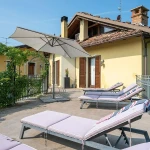You can find this route on the BikeSquare app with code A07
Ebike tour across the hills of the Monferrato astride Rocchetta Tanaro’s Natural Park.
Beautiful landscapes will frame this tour through woods and vineyards.
How to visit Belveglio
Our tour starts from Ortondo’s B&B in Cortiglione.
After a short ride on the crest of the hills surrounding the town, you will arrive at “Bricco di Belveglio”, a place wherer it is possible to have a 360 degrees view of the surrounding landscape.
Belveglio is a town of 336 inhabitants in the province of Asti. In the Middle Ages the town was known with the name of Malamorte. It is likely that the toponym derives from the continuous struggles that raged in the territory, such as to consider them lands of bad death. The first lord of Malamorte was Raimondo Turco (1003 - 1092), coming from a noble family of Asti.
The Aleramic marquises of Incisa became masters of the locality after the descent of Federico Barbarossa in 1155, who defeated and set fire to the city of Asti, but after the peace of Costanza (1183) they were forced to return it to the Municipality of Asti. Following the civil wars in Asti between the Solaro and Guttuari Malamorte factions, many destructions followed one another, up to the passage of the city of Asti under the domination of Luchino Visconti.
In 1387, the village appears in Valentina Visconti's dowry for her marriage to Luigi di Valois and probably in this period the locality changed its name to Belvedere (Bellumviderium Astensium).
In 1806, Napoleon Bonaparte included the village in the Department of Marengo and in this period the name changed (the last one) from Belvedere to Belveglio.
The route winds through the streets of the center of the village until it leaves the main road to start a long secondary road immersed in the surrounding woods.
Rocchetta Tanaro and its Natural Park
The track will lead you to the borders of the Rocchetta Tanaro’s Natural Park.
Pay attention to the descent on the gravel road that will allow you to enter the park and enjoy, in summer, some shade and coolness.
Leaving the main dirt road you will find yourself near the town of Cerro Tanaro, from where a long cycle path will start on the banks of the Tanaro river.
At the end of the track, a small tunnel will take you past the railway to reach (this time on asphalt) the town of Rocchetta Tanaro.
In the open countryside, once on the banks of the Tanaro, stands the small church of Santa Maria de Flexio with a Romanesque apse.
In the Sant'Emiliano region stands the homonymous church, formerly a dependency of the Abbey of Azzano which extended its jurisdiction over farmhouses and lands in the Rocchetta area bordering "Roca".
In the concentric, the Salone Santa Caterina, once the Church of the Confraternity of the ss. Annunziata or dei "Battuti", it preserves a chiselled fresco under study by the Superintendency of Artistic Heritage, Romanesque columns and corbels.
The parish church built in 1700 on a pre-existing medieval chapel dedicated to Saint Stephen, has a Romanesque bell tower dated 1474. It preserves a marble stoup with the engraved "Comunitas Rocheta 1476", a painting attributed to the Caccia school, a painting by Michelangelo Pittatore, an ivory crucifix by 1700 of Provençal school.
Also worth seeing is the Rocchetta Tanaro Natural Park, where the presence of “Il Frutteto della Memoria” and the "large beech" (called "Faggio Emilio") of the Val du Gè (Valle del Gelo), an ultra-centuries-old specimen over 25 meters and with a diameter of the crown of around 20 meters that grows to the minimum altitude for Piedmont (130 meters above sea level), and represents a reminder of the beech woods spread throughout the area at the end of the last glacial period, and the Integral Nature Reserve " Il Verneto ", WWF oasis.
In Rocchetta there are also two museums: the “Tanaro and Contadinerie Museum”, with the reconstruction of some typically Rocchettese peasant life environments, and the Museum of wine labels, an ideal journey through the Italian regions which, through its graphics, invites visitors to discover the best national wines;
Also worthy of note is the Castle of the Marquises Incisa della Rocchetta, where for centuries the wines of the Marquises Incisa della Rocchetta were produced in the cellars, transferred since 1994 to "La Corte Chiusa" (an ancient family property).
A cylindrical tower and parts of the building remain of the ancient medieval castle. The castle is now privately owned (not open to visitors).
Continuing along the track, you will arrive to take the road towards the Mogliotti’s Road to rejoin the track of the starting point again.






